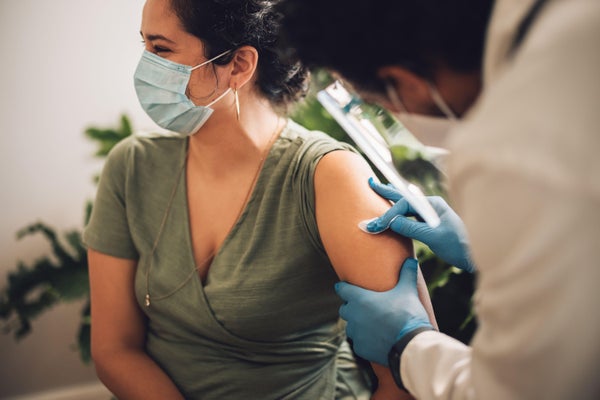At least 200 million people worldwide have struggled with long COVID: a slew of symptoms that can persist for months or even years after an infection with SARS-CoV-2, the virus that causes COVID. But research suggests that that number would likely be much higher if not for vaccines.
A growing consensus is emerging that receiving multiple doses of the COVID vaccine before an initial infection can dramatically reduce the risk of long-term symptoms. Although the studies disagree on the exact amount of protection, they show a clear trend: the more shots in your arm before your first bout with COVID, the less likely you are to get long COVID. One meta-analysis of 24 studies published in October, for example, found that people who’d had three doses of the COVID vaccine were 68.7 percent less likely to develop long COVID compared with those who were unvaccinated. “This is really impressive,” says Alexandre Marra, a medical researcher at the Albert Einstein Israelite Hospital in Brazil and the lead author of the study. “Booster doses make a difference in long COVID.”
It is also a welcome departure from earlier studies, which suggested that vaccines provided only a modest defense against long COVID. In 2022 Marra’s team published a meta-analysis of six studies that found that a single dose of the COVID vaccine reduced the likelihood of long COVID by 30 percent. Now, that protection appears to be much greater.
A study published in November in the BMJ found that a single COVID vaccine dose reduced the risk of long COVID by 21 percent, two doses reduced it by 59 percent and three or more doses reduced it by 73 percent. Vaccine effectiveness clearly climbed with each successive dose. “I was surprised that we saw such a clear dose response,” says Fredrik Nyberg, an epidemiologist at the University of Gothenburg in Sweden and one of the co-authors of the study. “The more doses you had in your body before your first infection, the better.” That lines up with the findings of several new studies, which similarly show this ladderlike benefit. Marra’s October 2023 meta-analysis found that two doses reduced long COVID likelihood by 36.9 percent and three doses reduced it by 68.7 percent. And in a study published last year in the Journal of the American Medical Association, other researchers found that the prevalence of long COVID in health care workers dropped from 41.8 percent in unvaccinated participants to 30 percent in those with a single dose, 17.4 percent with two doses and 16 percent with three doses.
These studies were conducted in various countries with differing health care systems, demographics, COVID vaccination uptake and COVID prevalence. As such, Marra notes that the COVID vaccines’ effectiveness against long COVID will vary and may not be generalizable to other settings. Still, the consistency of the studies’ findings is telling—regardless of their settings, many studies agree that boosters provide potent protection against long COVID. Marra’s recent meta-analysis, for example, showed that the prevalence of long COVID in the early years of the pandemic was consistently above 20 percent. Today rates of long COVID have dropped, likely thanks to increased immunity, milder variants and improved treatment. Yet there is still a sharp divide between unvaccinated and vaccinated people. The prevalence of long COVID is currently 11 percent among those who are unvaccinated and 5 percent among those who have had two or more doses of the vaccine. “It is a significant difference for those who are unwilling to take the risk,” he says.
The question is why. It could be that these vaccines help prevent severe COVID itself, which is a risk factor for long COVID. But that does not appear to be the whole story—in part because the boosters have also been shown to shield people who had only a mild COVID infection. Unfortunately, the precise mechanisms at play are hard to disentangle because the cause of long COVID itself is still cloaked in mystery. One possibility is that the virus lingers in the body, hiding in various organs—such as the gut or brain—and causing chronic inflammation. Another is that long COVID is an autoimmune disease in which the immune response triggered by the initial infection wages an extended war against the body, causing symptoms long after the initial infection has been cleared.
For both scenarios, boosters give people the upper hand, argues Akiko Iwasaki, an immunologist at Yale University who is co-leading a clinical trial on long COVID. That is because boosters enhance antibodies—increasing both their numbers and their ability to bind to the virus—as well as T and B immune cells that help fight the virus. With both components, “people who take the booster shots have an improved ability to fight off infection,” Iwasaki says. And that is key, allowing the booster to quash a growing infection before it spirals out of control. “The more you can prevent the replication and spread of the virus within the body, the less chance the virus has to seed a niche—to establish reservoirs or cause excessive inflammation that leads to autoimmunity,” she says.
Although it will take time to pinpoint the exact reason behind vaccines’ protective effect against long COVID, many medical experts are hopeful that the new studies will help counter the spread of misinformation and disinformation about the COVID immunizations that has contributed to vaccine hesitancy. But experts also note that while vaccines reduce the risk of long COVID, they do not eradicate it, and protection may wane over time. “Breakthrough infections can still occur, and the dynamic of the virus—including the emergence of new variants—add complexity to the situation,” Marra says. As such, he notes that it’s important to continue to follow public health guidelines to minimize the impact of COVID, including the risk of long-term symptoms.
